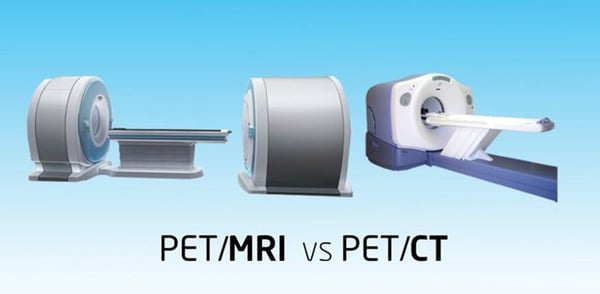Since PET/MRIs have hit the scene, there’s been a lot of talk about how they will affect the use of PET/CTs, and whether or not the use of PET/MRIs will take off or not. Let’s start with the basics about the newer PET/MRI. 
PET/MRI combines the power of whole body imaging (MRI) with Positron Emission Tomography (PET). By doing so, it can detect, characterize, stage and treat a variety of diseases more accurately, including oncological, cardiovascular and neurological diseases. The big news is it reduces radiation exposure dramatically, which is especially significant when imaging children.
Think of it as a hybrid scanner. The MRI produces detailed morphological information about the organs, structures and tissues in the body. The PET helps measure their functionality. This can give physicians a more accurate and much more precise assessment of disease. As a result, detection of disease can be faster and easier, which means treatment can commence sooner. And again, there’s the fact that it exposes patients to lower levels of radiation.
Currently, four manufacturers offer PET/MRI systems. They are GE, MR Solutions, Philips and Siemens. However, while there’s been lots of excitement about PET/MRI, sales have not been overwhelming.
Let’s look at the differences between PET/CT and PET/MRI:
- PET/CT scanners can’t perform simultaneous data acquisition. PET/MRI can.
- PET/CT has significant radiation dose. PET/MRI has lower levels of radiation.
- PET/CT can perform lung and bone imaging. PET/MRI really can’t.
- PET/CT can’t hold a candle to the contrast among soft tissues delivered by PET/MRI.
- PET/CT does not deliver as good contrast for functional-imaging capabilities. PET/MRI does.
- PET/MRI costs more than PET/CT and has a longer acquisition time.
- PET/MRI has a limited field of view and dependence on bone for AC calculations because it has to rely on MR instead of X-Ray. This is one of the major reasons PET/MRI is not taking off.
- PET/MRI differentiates between viable tissue and areas of necrosis after surgery and radiation therapy. PET/CT does not. It also improves the detection of low-grade or less-FDG avid lymphomas and increases the detection of tumor recurrence and newly developed distant metastases.
- PET/MRI demonstrates a higher capacity for mapping recurrent prostate cancer than PET/CT, according to a recent study presented at SNMMI’s 60th Annual Meeting in Vancouver, British Columbia.
It will be interesting to see if the market begins to embrace PET/MRI in the months to come.
As always, if you need help determining which technology is best for your clinic, hospital or healthcare facility, please reach out to the experts at Atlantis Worldwide. While refurbished and used PET/MRIs are not yet available, it’s just a matter of time before they are. For your pre-owned PET/CT needs contact us today!
Some blogs you may have missed:
- CT Scanner Slice: Handy Guide
- Comparing C-Arms: The Ultimate Guide
- Selling Your Used Medical Imaging Systems vs Trading-in
- Extend Your CT Tube Life by 40% or Greater
- CT Scanner: Air Cooled vs Water Cooled
About the author: Vikki Harmonay




